LWHG at Moseley, West Midlands, 2017 - 2019 |
A LWHG appeared at Swanshurst Park, at Moseley, West Midlands, during February 2017, when it was in 1W plumage. It re-appeared in late-October, still in its 2cy but having moulted into 2W plumage, and yet again in November 2018 (in its 3cy and exhibiting 'advanced' 3W plumage) and in November 2019 (in its 4cy and in near-adult plumage). In its first and second calendar years it proved to be an exemplar of a controversial LWHG. During its initial sojourn, especially, opinions were divided between Caspian Gull and Yellow-legged Gull and, in the field, the appearance did vary quite extensively, depending upon posture, light conditions and even which side of the bird was in view. The size and structure were slight and delicate for Yellow-legged Gull and this was certainly a significant factor promoting suggestions that it was a Caspian Gull. This was supplemented by aspects of the plumage, particularly internal markings on the scapulars and coverts. Plumage tracts which provide clues to distinguishing between Yellow-legged Gull and Caspian Gull are at a maximum during 1W, become fewer in 2W and 3W, and are restricted to primary pattern as adult plumage is obtained. The images and text below document the gull's variability in appearance, its developing appearance as it matured and discuss particular traits. After successive moults, it became clear that there was near-certainly michahellis in the gull's lineage, particularly evident in its bare parts (though see comments below on the surprising appearance of some known hybrids). By its fourth winter there were few if any plumage features that were incompatible with michahellis. The primary pattern did not match the 'classic' pattern of a western Yellow-legged Gull but was within the range of variation, especially individuals originating from the eastern Mediterranean and Black Sea region. Apart from this slight 'excess' of white in the primary pattern compared with a 'classic' western michahellis, by its fourth winter there were no aspects of the primary pattern clearly suggestive of cachinnans. The intention of this text is not to contest or promote any particular diagnosis but to document the intriguing level of variability and make the case for caution in ascribing the gull to a 'thoroughbred' taxon. The possibility of 'mixed lineage' is discussed. The perplexing appearance of some known hybrid LWHGs with yellow legs was documented by Neubauer et al. (2010).

© A. R. Dean
Plate 1. Here the neck is neither unduly extended nor settled into
the shoulders and the posture appears relaxed.
The head appears proportionately small and has a slightly pear-shaped outline,
with somewhat extruded
maxillary feathering leading into a quite pointed-looking bill. The eye is
set well forward and close to the forehead.
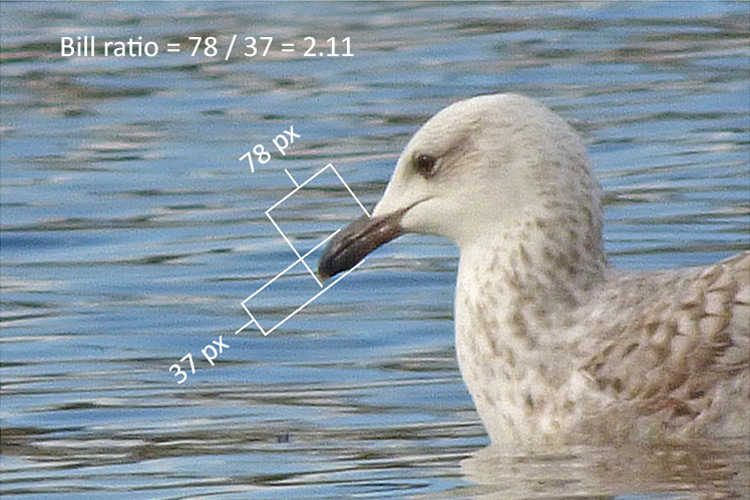
© A. R. Dean
Plate 2. This plate illustrates the technique for measuring
bill-ratio, as employed in the key paper on Caspian Gull identification
by
Chris Gibbins et al (see References).
Here the bill ratio is approx. 2.11 while the mean measured from several photos was
2.15.
This is low for Caspian Gull, where Appendix 1 in Gibbins et al.
indicates a mean for 1W of c. 2.55 with SD of 0.25.
Conversely, a value of
2.15 is high for YLG, which has a mean of c. 1.90 with SD of 0.15 (own data
from photos).
Thus, in its1W, the Moseley gull
has a ratio somewhat 'in between'.

© A. R. Dean
Plate 3. Here the head is settled more towards the shoulders, with
the neck compressed. The head appears proportionately larger
and slightly
more bulbous.
The bill shows
an evident gonys. With the left-side in view, the upperparts appear quite
coarsely marked,
with some
second-generation scapulars
showing broad, almost triangular, interior marks and a 'double barred'
pattern.
The under tail coverts are quite coarsely marked.
When the gull was standing on the embankment,
retained central
greater-coverts revealed a barred / notched pattern.
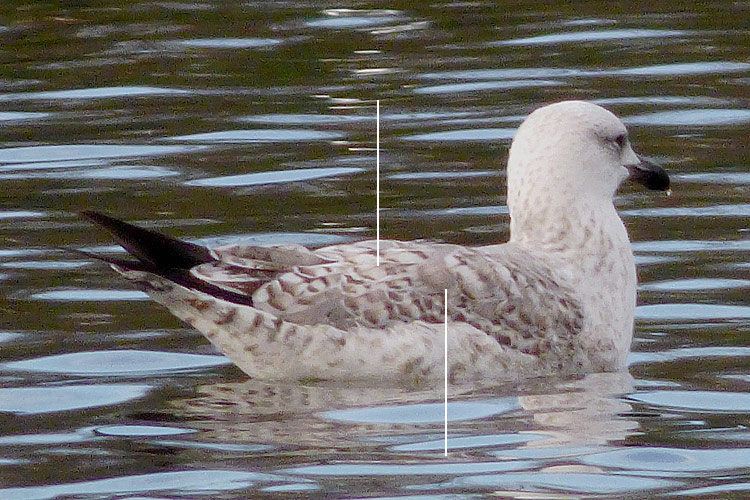
© A. R. Dean
Plate 4. On the right side, the second-generation scapulars were
less-heavily marked, with several feathers showing a subterminal anchor
and a fine mesial streak but extensive and 'clean' areas of grey
basally. Tertials also atypically variegated for both cachinnans
and michahellis,
though perhaps more likely in the latter.

© Graham Fellows
Plate 5. The inner primaries show grey on inner webs reaching the
edge of the wing, creating a 'venetian blind' pattern.
There are pale 'lozenges' at the extremities of the inner webs. The outer
webs are dark but have pale lines internally.
The underwing shows a pale and relatively plain centre and the underside of
the primaries is also pale.
In combination, this produces a rather 'hollowed out' appearance
overall. The tail has a black terminal band
of quite even but unexceptional depth and has black 'spots' internally, The
bases of the outer feathers are more-cleanly white.
In late-October what was evidently the same individual re-appeared. Still in 2cy but now in 2W plumage, its relatively small size and rather dainty structure were the same and, at both seasons, it was easy to find LBBGs which were larger than it.
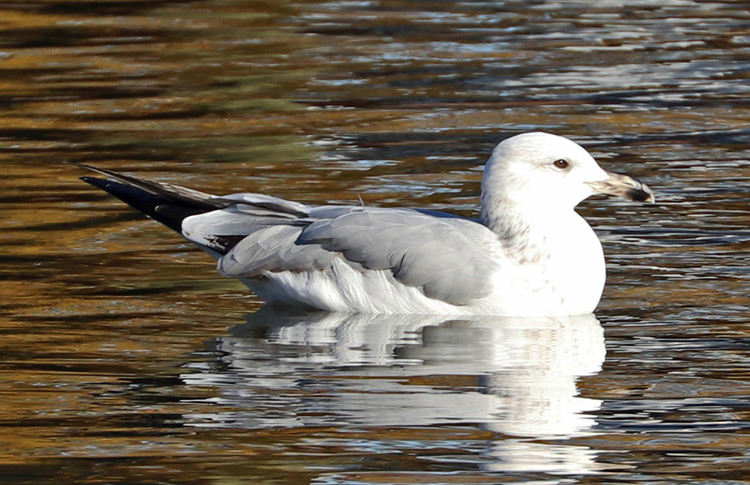
© A. R. Dean
Plate 6.
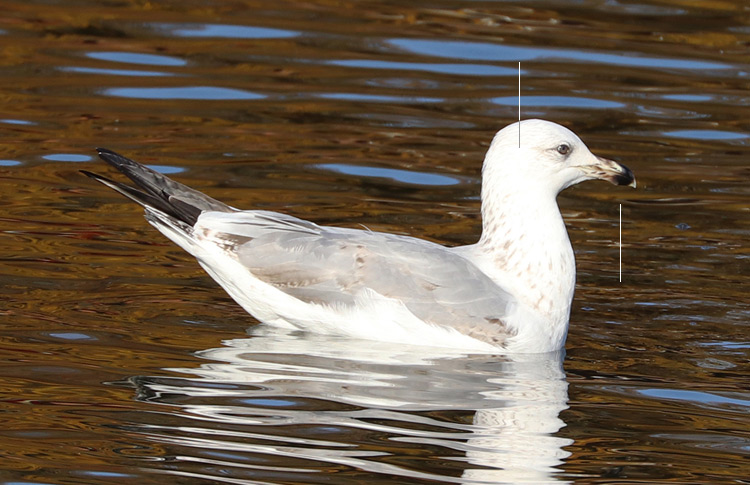
© A. R. Dean
Plate 7. Compare plates 6 & 7 with plates 1 & 3. Again note how
posture affects impressions of relative size and shape of head and bill.
In plate 7 note the evident gonys (YLG-like) but the lack of conspicuous
streaking on ear-coverts (the corresponding lack of an 'eye-mask' is unlike
most 2W YLG).
Although here the iris looks quite dark, there are indications of emerging
colour.

© A. R. Dean
Plate 8. Here bill ratio is approx. 1.84, thus lower than as measured in February (in 1W) and too low for a Caspian Gull per se.
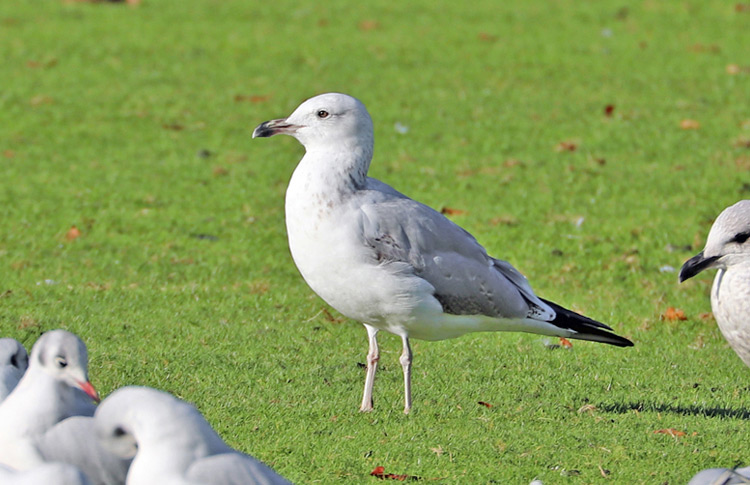
© A. R. Dean
Plate 9. At times the size and structure appeared very dainty, almost
recalling an over-sized Common Gull.
Note the relatively small yet rounded head and slight bill and also the very
attenuated rear end. Iris here appears grey.
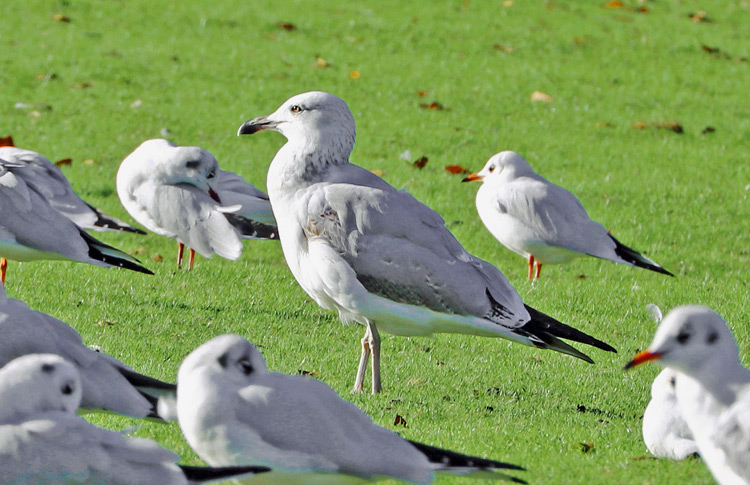
© A. R. Dean
Plate 10. At other times there was a marked resemblance to the
posture and structure of Caspian Gull, with head appearing relatively small
and forehead low, bill looking slender and posture upright,
with a rather vertical line to breast and fore-belly.
Again note the lack of prominent streaking around eye but iris (here catching
the sun) with a distinctly pale hue.
The extent of grey in the upperparts is extensive and more adult-like than
in many 2W YLG of this age (Olsen & Larsson).

© A. R. Dean
Plate 11. Demeanour here somewhat more-robust but note size and structure of both body and bill in comparison with LBBG (probably a male).
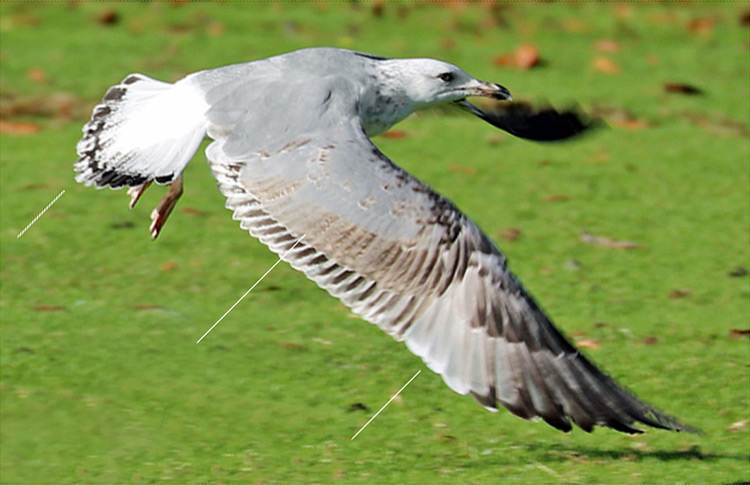
© A. R. Dean
Plate 12. As evident in 'standing' images, there has been extensive
moult of wing coverts
(as well as mantle, scapulars and flight-feathers), creating a much
more-advanced appearance than in 2W HG and many YLG.
Note patterns of tail, gc and inner primaries all of which are more
associated with Caspian than YLG, at least according to some sources.

© A. R. Dean
Plate 13. Again note the patterns of innermost primaries, creating a
rather uniform pale grey 'window', a feature more often seen on Caspian.
Also the whitish underwing. Conversely, a small white mirror on p10 is a feature exhibited quite frequently by 2W
Caspian but there is no sign of that here.
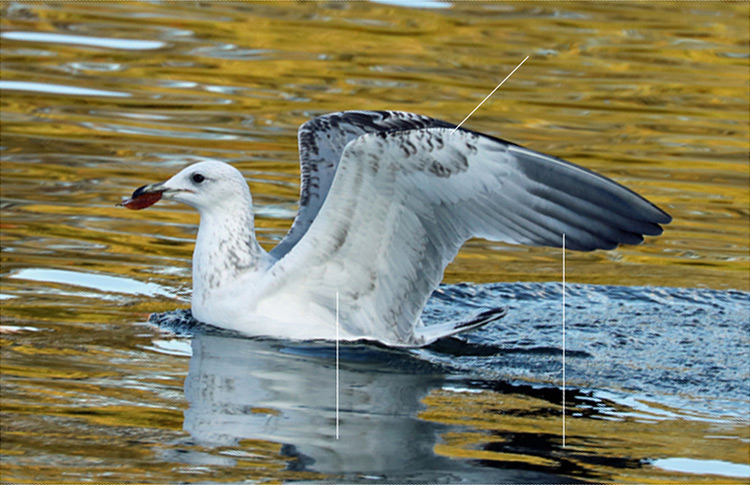
© A. R. Dean
Plate 14. Note white appearance of underwing, with significant marks
restricted to primary coverts.
Also evident pale inner webs to central primaries, creating a pale centre to
the 'hand'.
(The gull has a leaf in its bill, so bill shape and gonys not evident)
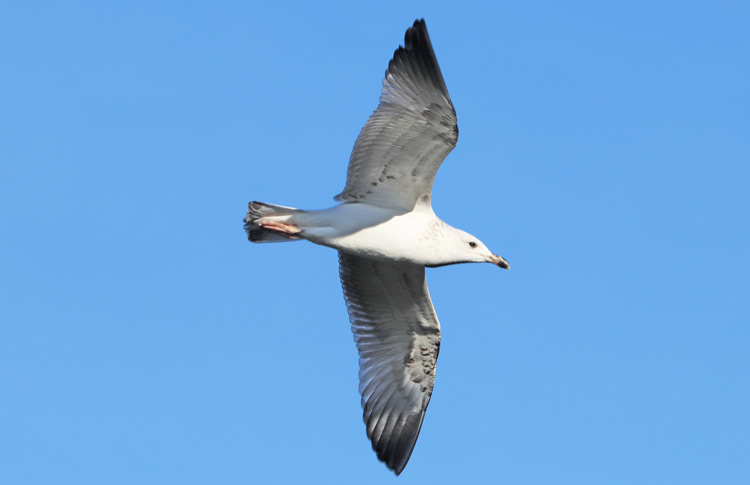
© A. R. Dean
Plate 15. Pale underwing and unmarked axillaries again evident, as are uniformly pale-looking innermost primaries and pale 'veins' on central primaries.
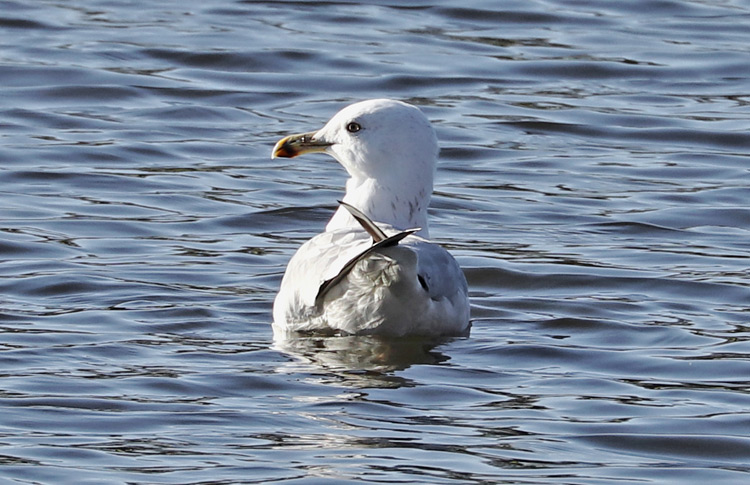
© A. R. Dean
Plate 16. Now in 3W plumage. Note very white head, lacking 'eye-mask' and with evident streaking confined to a 'necklace' at base of hind-neck. Note also pattern of underside of p10.

© A. R. Dean
Plate 17.
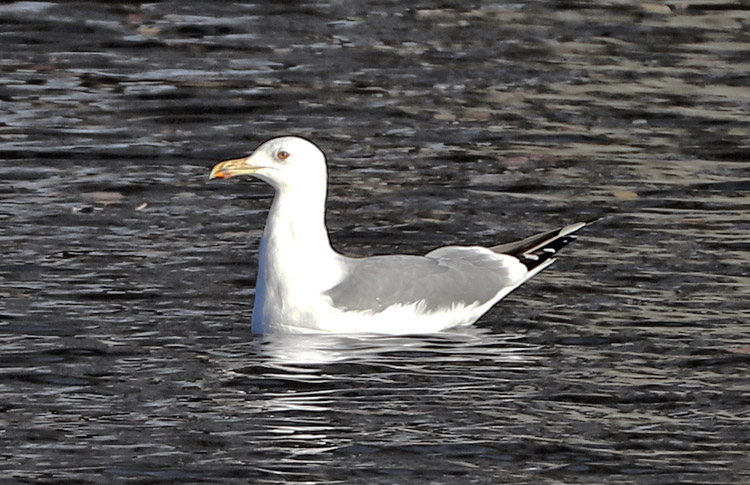
© A. R. Dean
Plate 18.

© A. R. Dean
Plate 19. In plates 16 to 19 note yet again how head-shape and
apparent position of eye vary markedly depending on posture and
demeanour.
In plate 19, there is a definite michahellis-like demeanour but this
is less evident in plates 16, 17 and 18.
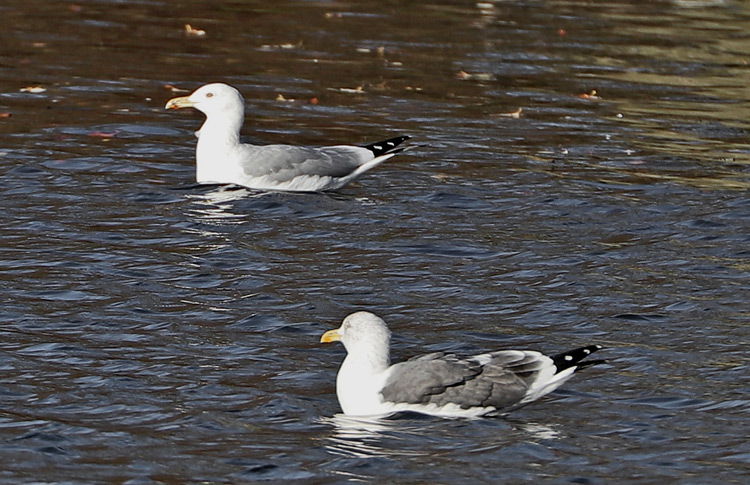
© A. R. Dean
Plate 20. Note flat-backed appearance, lack of 'tertial step' and
very attenuated rear end compared with the LBB Gull.
(However, telephoto effect has exaggerated the apparent size difference,
which was in fact much less than it appears here)

© A. R. Dean
Plate 21.
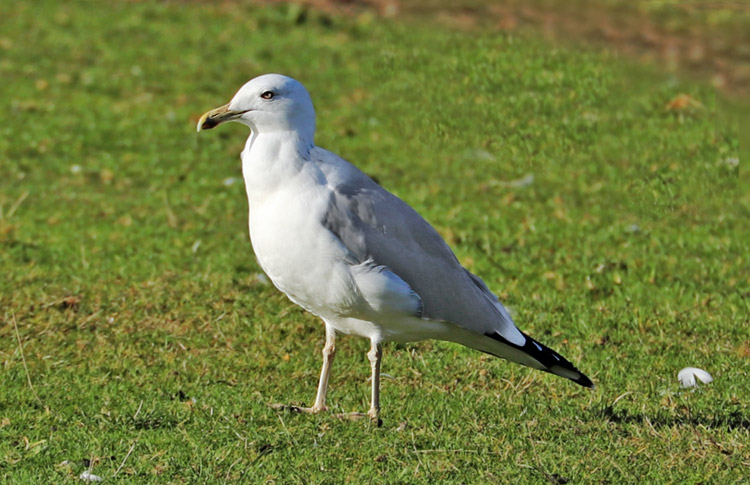
© A. R. Dean
Plate 22.
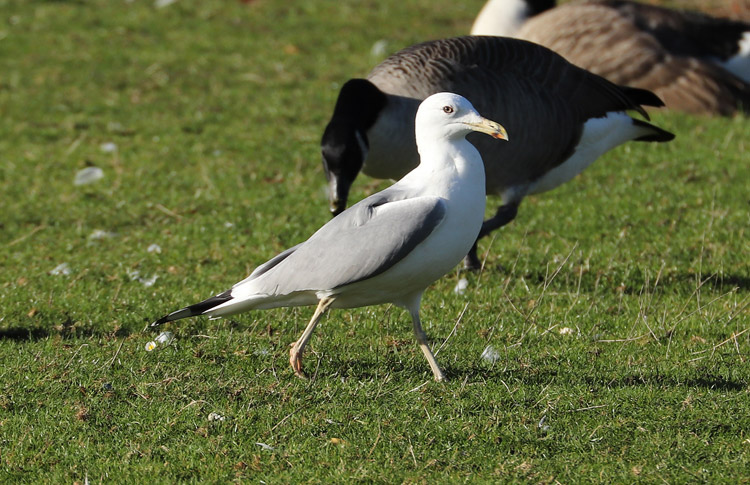
© A. R. Dean
Plate 23. Note considerable variation in structure and relative
proportions between plates 21, 22 and 23.
Note also the evident 'keel' behind the legs. Compare with plates 9 and 10,
showing the gull in the previous winter.
This demonstrates that such variations were characteristic and not 'one off'
aberrations.
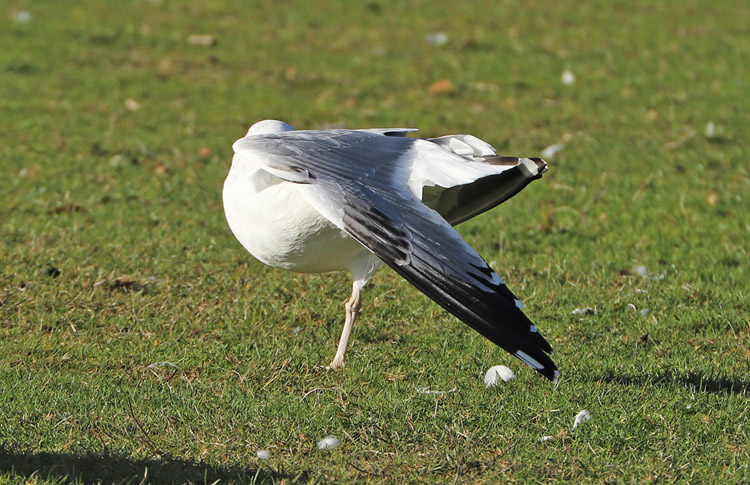
© A. R. Dean
Plate 24. Here there is a suggestion of grey 'leads' into the base of
the outer primaries (c.f. plate 26).
However, note also the large, lozenge-shaped, michahellis-style
mirror now present on p10 (see also plate 27 but also plates 29 et seq.).
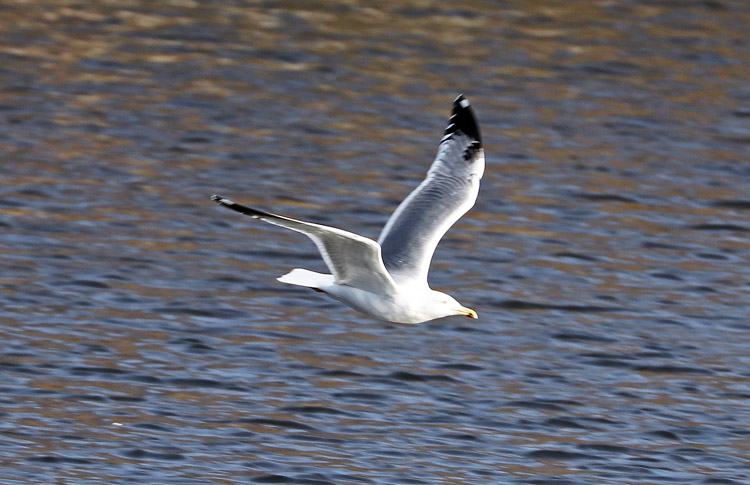
© A. R. Dean
Plate 25. Even in 3W, there is still just a single mirror (on p10)
with no sign of a mirror on p9.
Note very extensive moult, with pure white tail and pristine grey mantle,
scapulars and secondary coverts (black streaking being confined to pc and
alula).
The appearance could well be attributed to 4W were the history of the bird
unknown.
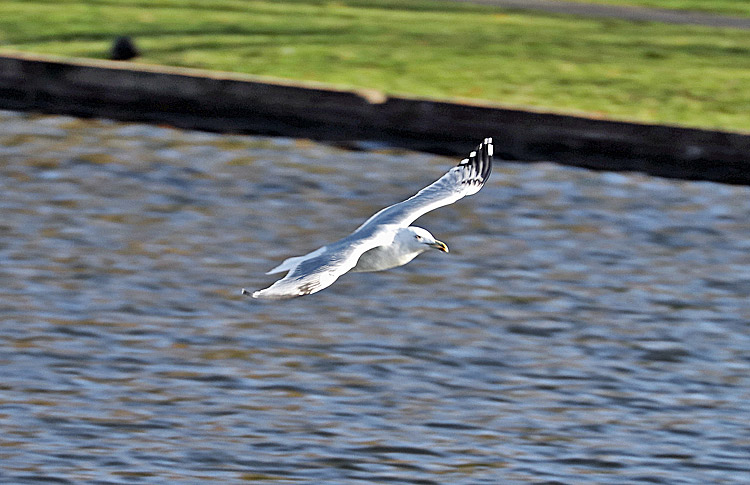
© A. R. Dean
Plate 26. In plate 25 the black in the primaries appears 'solid' and
rather' square cut' across the 'hand'.
In plate 26, however, there are indications of grey 'leads' cutting into the
base of the outer primaries (c.f. plate 24).
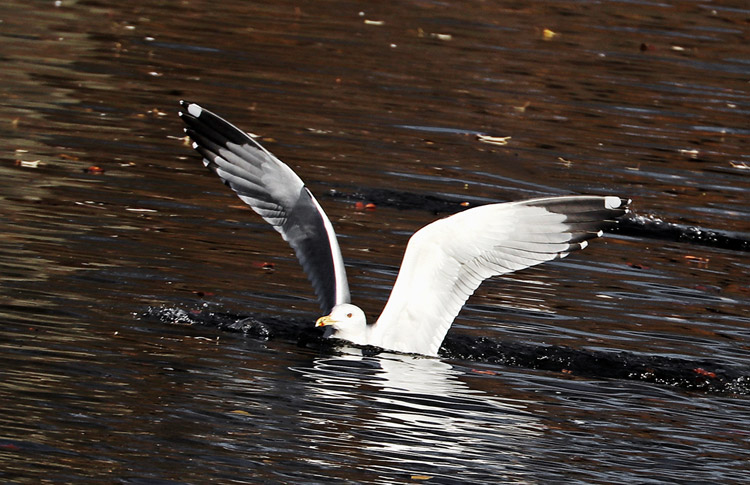
© A. R. Dean
Plate 27. The underwing shows extensive black in the primaries and no
sign of a mirror on p9.
While not excluding cachinnans, the
pattern is typical of michahellis.
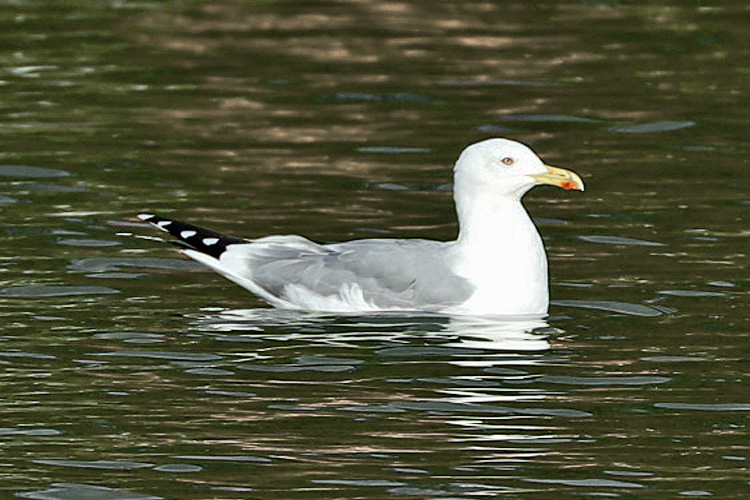
© A. R. Dean
Plate 28. Now in its fourth winter, size and structure naturally
remain unchanged from previous winter.
Here, rather flat, low, bodyline and slim, very attenuated rear end are well
displayed.
As in previous years, however, the profile of body and head were very
dependent upon posture.
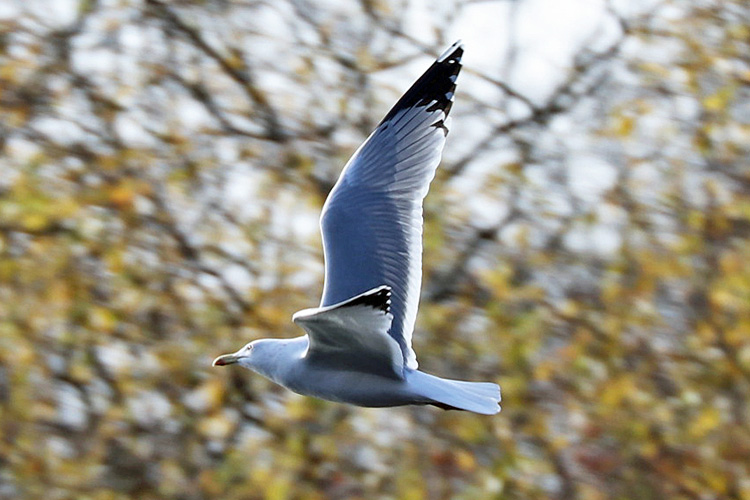
© A. R. Dean
Plate 29. Primary pattern shows slight changes from 3W. This is not
unexpected but note long white tip to p10 with just a small black spot on
outer web.
Thus, the broadly demarcated, lozenge-shaped mirror which was present in 3W
and is characteristic of a 'classic' western michahellis has been
lost.
Note also the white mirror on p9 and reduced extent of black at base of p7.
However, this additional white and reduced amount of black in the primary
pattern overall remains
within the range of variation of michahellis, especially individuals
of more-easterly origin (a full white tip is deemed to be primarily a male
feature,
though the size and structure of the Moseley gull suggest it is a female)
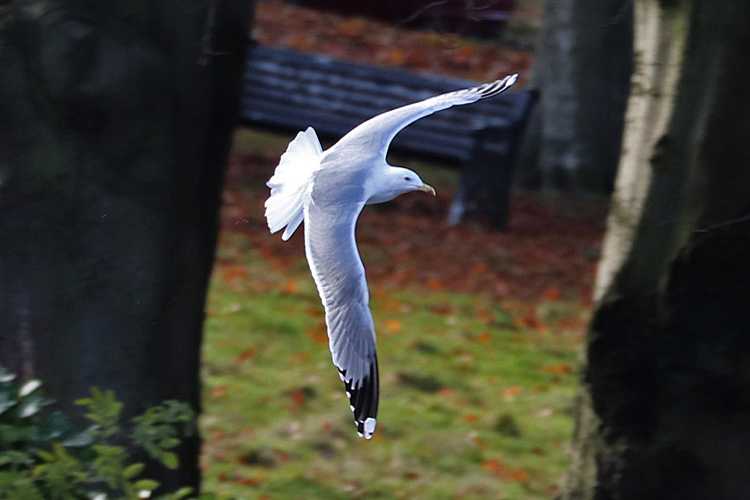
© A. R. Dean
Plate 30. As in plate 29, note the newly acquired primary pattern. Also, a few retained dark streaks on pc, indicative of 4W but sometimes retained in older ages.
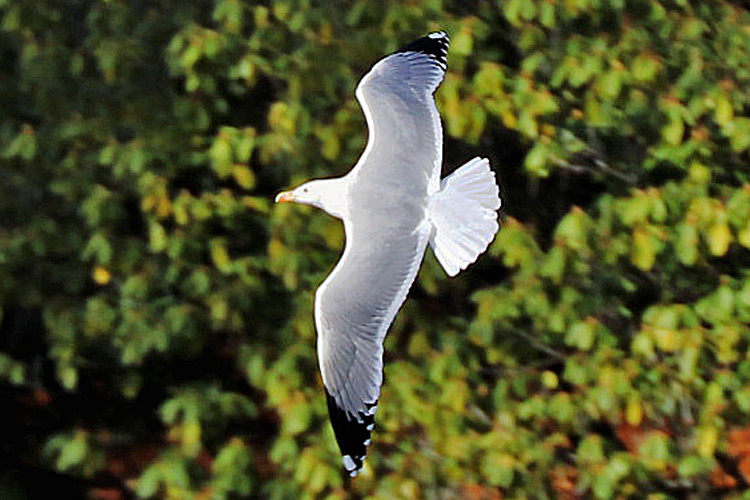
© A. R. Dean
Plate 31. Here it can be seen that on the left wing (unlike the right
wing) there is a narrow black bar across both webs of p10.
Despite a slight reduction in black in the primary pattern it remains as a
relatively solid 'block' inwards from p10.
Some 'indentations' apart, there is no sign of extensive pale tongues
cutting into the black on the inner webs.
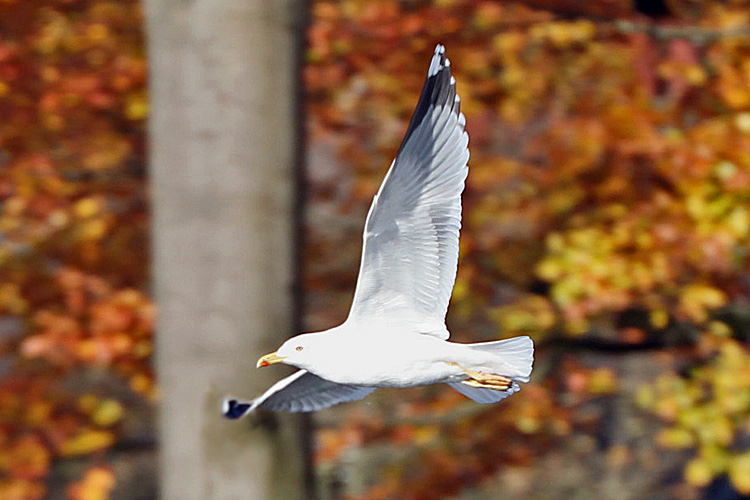
© A. R. Dean
Plate 31. The primary pattern on the underwing matches that on the
upperwing. Note also the yellow legs.
While the yellow hue is rather pale (as with the bill) full depth of colour
is unlikely to be attained until later than 4W.
The photos above illustrate why this LWHG generated so much debate and differing conclusions, particularly in its first winter. Its shape and structure were decidedly 'malleable', at times appearing slender with suggestions of a Caspian-like head and bill-structure, at other times appearing more robust with a squarer head-profile and a stockier and blunter-looking bill, more reminiscent of Yellow-legged Gull. In terms of structure, Caspian Gulls termed 'classic'are, in truth, the 'most distinctive' and not necessarily the 'most typical'. The popular image of Caspian Gull is something of a caricature (most casual sketches of the species, for example, depict a wholly exaggerated bill ratio (length : depth) -see below). Any individual which does not match this overstated (or at least 'exceptional') appearance inevitably shifts its demeanour towards that of its congeners. However, in the field, the Moseley gull certainly did not match the 'classic' Caspian Gull image with any consistency, though it did so periodically
Assessing the features visible in the images of 1W plumage, the barred greater coverts and under tail coverts tend to favour Yellow-legged Gull. The whitish 'core' to the underwing and the 'venetian blind' and 'lozenge' patterns of the inner primaries are said in some texts to favour Caspian but the pale internal lines on the outer webs may be more frequent in Yellow-legged. Coarse cross-bars on second-generation scapulars are deemed to favour Yellow-legged while the plainer more-extensively pale grey feathers are associated with Caspian. The width of the tail-band better matches Caspian but the interior pattern favours Yellow-legged. The pattern of the tertials is more variegated than is usual in either Yellow-legged or Caspian.
There are fewer plumage clues to differentiating between Caspian and YLG in 2W and subsequent plumages but four features evident when the gull re-appeared at the end of October 2017 and again in subsequent years showed that it is not a Caspian Gull per se.
First the bill has a well-defined gonys, better defined than earlier in 2017. To some extent this is a result of the narrow (almost 'waisted') base to the bill but, even so, it is too bulbous for all but an exceptional Caspian.
Secondly, the bill-ratio is too low based upon fresh measurement from the newer images. Bill dimensions, especially bill depth, do increase somewhat as gulls mature. Data in Olsen & Larsson indicate that mean bill dimensions in adult Caspian Gull exceed those of 1W by c. 0.8% (F) to 1.5% (M) in length but by c. 5% (M) to >10% (F) in depth at gonys. Measurements from photos of the Moseley gull in 1W indicated a ratio of approx. 2.15, thus rather intermediate between the values expected in Caspian Gull and YLG, respectively. With the later photos in 2W (and 3W), a value of around 1.85 is indicated, which is well below values expected in Caspian.
Thirdly, the iris became paler in 2W and yet more so in 3W. Some near-adult and older Caspians do have a pale iris but on most the eye looks dark, small and beady.
Finally, the second-generation and third generation penultimate primary, p9, lacked a small mirror.
Several of these features are 'percentage' characters rather than invariable and diagnostic but, in combination, they are not readily compatible with a diagnosis of Caspian.
When it returned in November 2018, in 3W plumage, the legs were a pale straw hue and appeared quite stocky (not long and spindly as in 'classic' Caspian). There had been an extensive moult, with mantle, scapulars and secondary coverts all pristine grey and with a pure white tail, with no sign of a residual tail-band. On the spread wing, black streaking was confined to the pc and alula. Were the history of the gull unknown, it could easily be diagnosed as 4W. Although sub-adult Caspian is sometimes stated to appear more 'advanced' compared with Yellow-legged of comparable age, some michahellis can appear as 'advanced' as the Moseley gull (pers obs). Thus, plumage tracts providing firm 'clues' were limited but there was still no sign of a mirror on p9. The outermost primary showed a large, lozenge-shaped mirror, very much as in 'classic' michahellis but not outside the range of sub-adult cachinnans.
Returning yet again in November 2019, the appearance was much as an adult, apart from some slight streaking on the primary coverts and (from a michahellis perspective) a less-than-full yellow hue to bill and legs. The primary pattern had more white and slightly less black than in 3W (not unexpected) but it is notable that the tip of p10 now showed a prominent white tip with a very narrow subterminal bar on the left wing and just a spot confined to the outer web on the right wing. The well-demarcated lozenge-shaped mirror had been lost. The resulting pattern is not outside the range of variation of michahellis but is not 'classic', as it was in 3W.
So, can a diagnosis of Yellow-legged Gull now be adopted? At times, the overall appearance of plumage and bare parts certainly indicated michahellis in the lineage. However, it is very easy to be selective when arguing the case for a particular identification and to dismiss traits which do not accord with a 'preferred' diagnosis. Also, as these gulls mature, there are far fewer plumage features to help with diagnosis. There are several features which suggest adopting a cautious approach. Features which suggest restraint before diagnosing the Moseley gull as a thoroughbred YLG include :
At times aspects of the shape and structure could be reminiscent of Caspian, to an extent difficult to equate with YLG, even a relatively small female.
The head was very white and lacked suggestions of a dusky 'eye-mask'. Evident streaking was confined to a partial 'necklace' at base of hind-neck.
In 2W the underwing was significantly white, with evident markings confined to the primary coverts.
In adult plumage the pattern of black and white in the primaries was within the range of variation of michahellis but was not 'classic' (especially for a presumed western female).
Not specifically in reference to this individual but, in earlier discussions of this species in December 2011, two other 2W Caspian Gull traits have been mentioned by Peter Adriaens :
Inner three primaries relatively uniformly grey across both webs, with a 'venetian blind' pattern (with darker outer webs) confined to the central primaries. Most 2cy Caspian show this pattern while in YLG the pattern is more evenly divided with individuals showing a 'venertian blind' effect across all the inner and central primaries (see images on Peter's website).
Inner webs to the outer primaries as viewed from below contrastingly pale, creating a somewhat 'hollowed out' appearance to the 'hand'.
A plethora of photos of first and second calendar year Caspian Gulls and Yellow-legged Gulls is available on the Gull Research Organisation website. Even a cursory examination there shows that, in practice, many features are 'percentage' features and not diagnostic. Some characters are within the range of variation of both species. It is unwise to be dogmatic about the identity (or at least the 'lineage') of an individual when several features are less than ideal. The character of both Yellow-legged Gull and Caspian Gull derives from a combination of features and is more than 'the sum of its parts'. A forensic analysis will often fail to provide a convincing diagnosis.
The problems arising from character variation and convergence are exacerbated by the issue of hybridization, which besets LWHGs more than any other group of birds. Part 2 of the paper by Chris Gibbins et al (2011) was dedicated to the issue of hybrids and the paper developed a 'scoring system' by which a 'hybrid index' could be calculated from a combination of traits. However, this applied to hybrids between Caspian Gull and Herring Gull (hitherto the most common source of problems) and most of the trait-scoring system does not apply to 1W Caspian versus Yellow-legged - where many features are much more convergent. However, as reported by Neubauer et al. (2010), hybrids between Caspian Gull and Herring Gull can, it seems, appear alarmingly similar to Yellow-legged Gull (to the extent that distinguishing them on the basis of appearance is impossible). See plates 213 - 215 in Neubauer et al. (2010), which show a known adult hybrid Caspian x Herring Gull which looks remarkably like a Yellow-legged Gull. Plate 216, showing a hybrid 1W Caspian x Yellow-legged Gull, is also instructive.
Thus, the identity of the Moseley gull is not of necessity a straight choice between Yellow-legged Gull and Caspian Gull. The possibility of hybrid origin also needs to be 'in the frame'. If encountering the Moseley gull for the first time as it appeared in its 4W (plates 28 - 31) then, with few misgivings, I would have diagnosed it as michahellis, while noting the more-extensive white in p10 than in a 'classic' individual. However, in its 1W and 2W, even after extensive observation in the field, the appearance to my eye did not 'resonate' convincingly and consistently as either thoroughbred Yellow-legged Gull or Caspian Gull. Its full history and plumage development (and the experiences of Neubauer et al.) have to be taken into account and signal a cautious approach.
When the gull was in its 1W and 2W I asked Chris Gibbins for his opinion and extracts from his replies follow.
In relation to the photos in 1W plumage:
'This is a tricky bird. [For a Caspian] the problem is the bill. I would suggest that the general structure of the bird is more like a female. Females obviously tend to have smaller bills that can look very weak, slender and contourless – but this bird has a very strong gonys. It has a strong angle and bulges. This I find most odd for a female. Perhaps in Romania or Ukraine or around the Caspian I would forgive this anomaly, but in UK then it’s a different matter.
I was at the IGM [International Gull Meeting] in Germany last spring and we visited several colony areas with mixed pairs. It is really alarming what is happening there; Herrings, Caspians and YLGs all together and all combinations involved in mixed pairs. Many of the birds we were seeing were birds that were outwith my experience of Caspians from Azerbaijan, Ukraine etc where I’ve visited breeding colonies, but nor could I fit them comfortably into Herring or YLG. A high % of assumed hybrids. It was fascinating but very alarming. So personally I’d be cautious with birds like this.'
In relation to the photos in 2W plumage:
'The bill is not right for Caspian and one or two other things, although they can be seen in second cycle Caspians (e.g. no p10 mirror, pale-ish eye) are less typical in this species. Nor does it look like a YLG. While I think we can never be sure, there seems to be enough here (and along with what it looked like in 1W) to suggest mixed parentage, though exactly what I'm not sure.'
Thus, Chris Gibbins too counsels 'caution' in attributing it to a given taxon. Such gulls will always divide opinion. Many problematic gulls are debated on internet discussion groups. Few discussions achieve unanimity of opinion. My own conclusion is that the Moseley LWHG exhibits a number of strongly michahellis features but its full lineage remains questionable ..... That's LWHGs.
Thanks to Graham Fellows for his photos showing the wing and tail patterns in 1W plumage, to Des Jennings for providing information about the return of the gull in late 2017 and 2018 and to Chris Gibbins for his informative comments.
|
|
|
|
Home |
Mediterranean
| Laughing |
Franklin's |
Little |
Sabine's |
Bonaparte's |
Black-headed |
Ring-billed | Common |
Lesser Black-backed | |